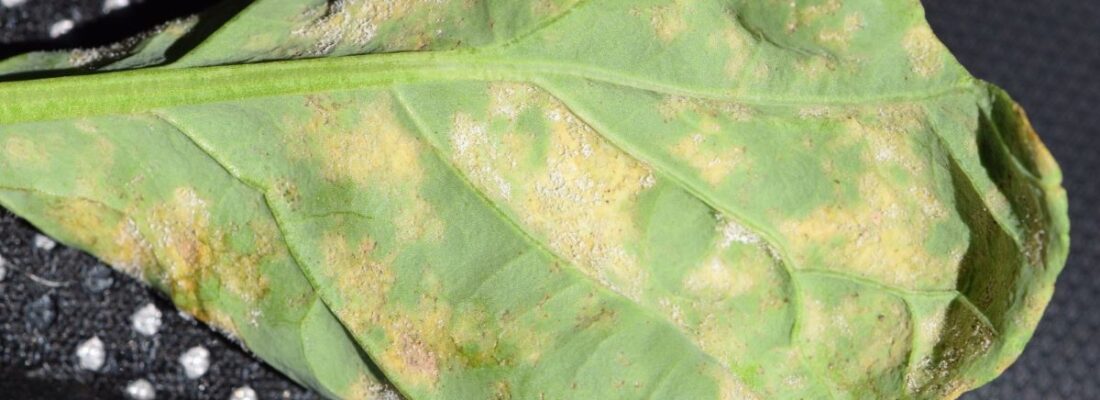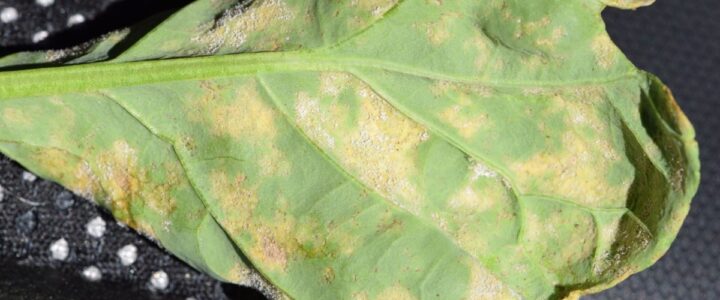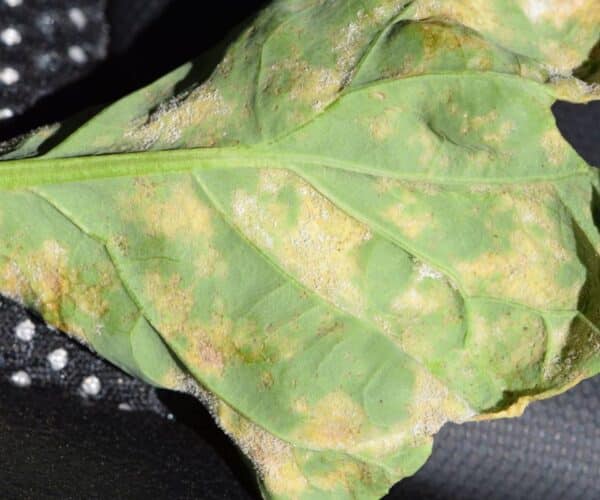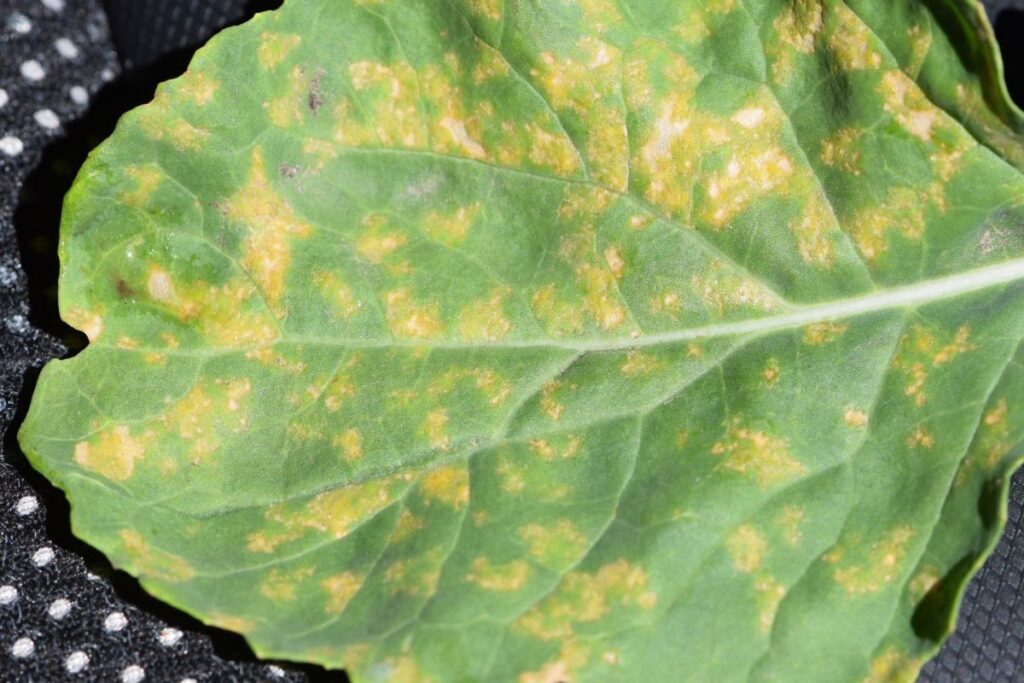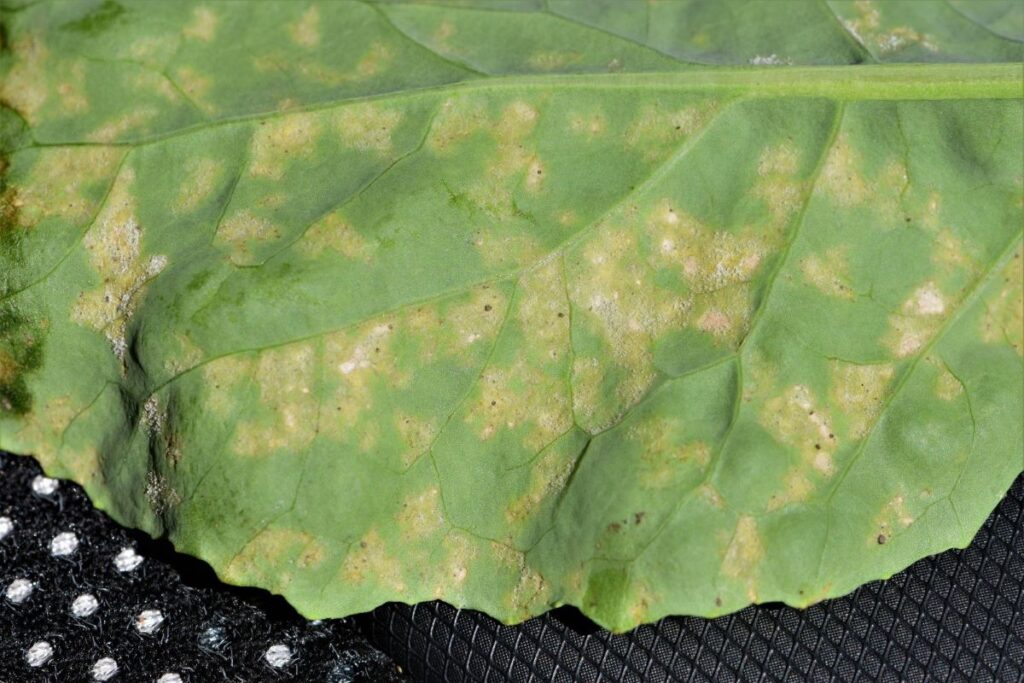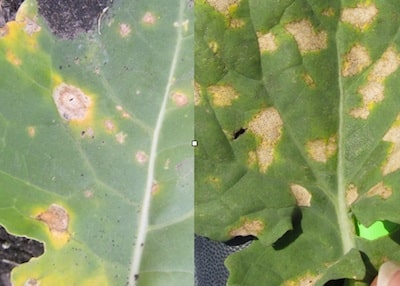Downy mildew is a plant disease caused by the pathogen Hyaloperonospora brassicae. Downy mildew is currently a minor disease that is not of economic concern for canola grown in Canada, as it has no known significant effects on seed yield and quality. Leaf lesions on the top surface of the leaf and mealy white conidiophores on the underside of the leaves can be used to identify downy mildew whenever scouting canola fields between seedling to podding stage, especially after high relative humidity and/or prolonged high moisture periods.1,2,3
Overview
Downy mildew disease in canola is caused by the pathogen Hyaloperonospora brassicae. It had previously been called Peronospora parasitica (which is now known to be the pathogenA disease-causing organism (such as a fungus or bacteria). More of shepherd’s purse), until it was updated to better align with its corresponding host species. Both H. brassicae (the pathogenA disease-causing organism (such as a fungus or bacteria). More that causes downy mildew disease) and the pathogenA disease-causing organism (such as a fungus or bacteria). More that causes white rust disease belong to group called oomycetes (or water moulds), which are not true fungi. H. brassicae is soil-borne and seedborne and may persist in the soil for five to 10 years.
Disease cycle
H. brassicae overwinters on infected crop residue as oosporesA hardy survival structure of an oomycete. Species of the Pythium genus (which causes root rots in canola) overwintering as an oospore. More. This pathogenA disease-causing organism (such as a fungus or bacteria). More then produces air-borne spores called conidiaSingle-cell spores or fungal propagules (such as those Verticillium species form). More, which infect canola leaves and other above-ground tissues. These newly infected tissues produce lesions in which new conidiophores develop and release more conidiaSingle-cell spores or fungal propagules (such as those Verticillium species form). More, which are a source of secondary spread and infection. H. brassicae prefer cool temperatures (8 to 24°C) and relative humidity above 80 per cent.1,2,3
Identification (disease symptoms)
Downy mildew disease symptoms can appear as early as the seedling stage or as late as the podding stage. Environmental factors, such high relative humidity and/or prolonged high moisture periods, can make the disease more likely to appear.
Symptoms of downy mildew disease in canola appear primarily on leaves and inflorescences (buds and flowers) and can become more evident as infected tissues age. Typical leaf lesions appear as discolored spots, sometimes chlorotic and/or necroticA symptom of plant cell or plant tissue death. More, on the top surface of the leaf. The underside of the leaves will commonly have characteristic mealy white conidiophores present in the lesions. Plants infected at the cotyledon stage may die if cotyledon infection progresses into the hypocotyl. Canola pods can be infected late in the season developing lesions as well.1,2,3
When scouting for disease in canola crops, downy mildew symptoms can usually be differentiated from other diseases:
- Downy mildew does not create morphological changes as white rust (staghead) does.
- While they can have leaf lesions, canola plants infected with downy mildew will not have the tiny black pycnidiaA type of fruiting body (produced by a pathogen, such as the blackleg-causing Leptosphaeria maculans pathogen) that appears as pepper-like spots (which are spore-bearing structures) within lesions. More spots that blackleg-infected plants will have.
- Since the pathogenA disease-causing organism (such as a fungus or bacteria). More causing downy mildew needs a living host to survive, it likely won’t exhibit premature ripening and doesn’t severely degrade cellular tissue the way sclerotinia stem rot disease does (ex. causing bleached stalks that shred and shatter easily).
- While powdery mildew disease also causes white growth on canola leaves, powdery mildew is best noticed at swath timing when white clouds of dust are released.
- Similarly, alternaria disease tends to exhibit symptoms later in the season than downy mildew symptoms would typically be found, despite both plants diseases cause leaf lesions.
Management
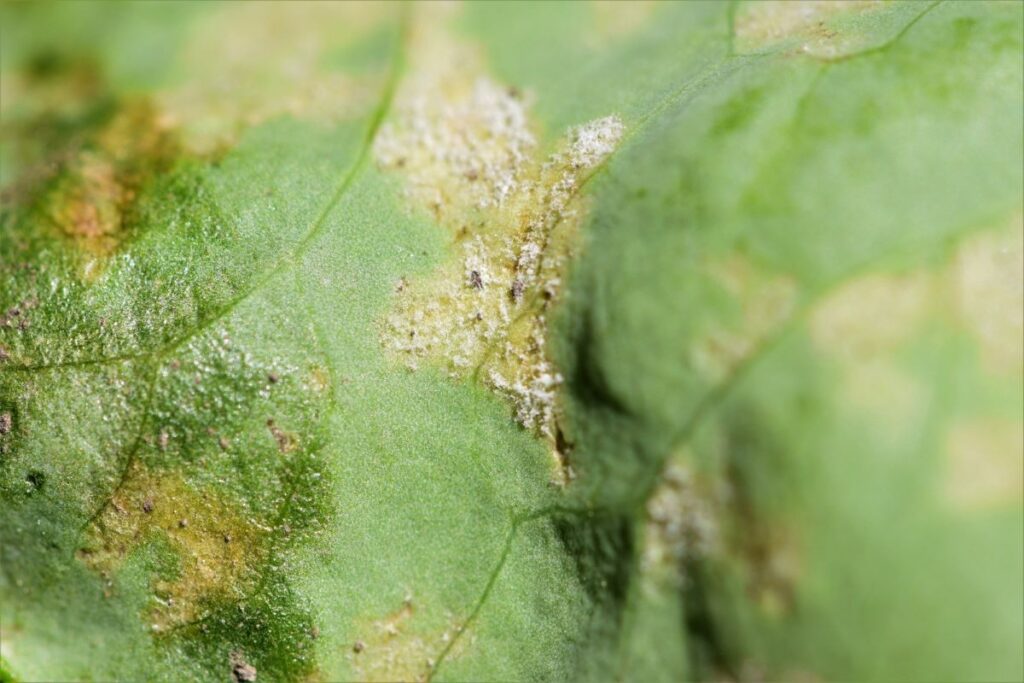
There are currently no fungicides registered for control of downy mildew in canola 4. Using a crop rotation with non-cruciferous crops, ensuring control alternate hosts such volunteer canola, stinkweed and wild mustard is recommended for general canola disease management.
Resistance in B. napusAlso referred to as Argentine canola, it is the species of canola currently commonly grown in Canada. More, B rapa, and B. junceaAlso referred to as brown mustard, it is a minor crop (from the Cruciferae or Brassicaceae plant family, commonly known as the mustard family) grown in Canada. More to downy mildew disease has been reported in the scientific literature, but cultivar resistance in Canada is not tested or reported publicly. Currently downy mildew is not a disease of economic concern for canola grown in Canada, and has no significant effects on seed yield and quality.1,2,3,5
Footnotes
- Runno-Paurson, E., Lääniste, P., Eremeev, V., Kaurilind, E., Hõrak, H., Niinemets, Ü., & Metspalu, L. 2019. Evaluation of downy mildew (Hyaloperonospora brassicae) infection severity on different cruciferousPlants belonging to the family Brassicaceae or (previously referred to as) Cruciferae. More oilseed crops. Proceedings of the 9th International Scientific Conference Rural Development 2019. http://doi.org/10.15544/RD.2019.047[↩][↩][↩][↩]
- Mohammed, A. E., You, M.P., Banga, S. S., & Barbetti, M. J. 2019. Resistances to downy mildew (Hyaloperonospora brassicae) in diverse Brassicaceae offer new disease management opportunities for oilseed and vegetable crucifer industries. European Journal of Plant Pathology, 155, 915-929. https://doi.org/10.1007/s10658-018-01609-7[↩][↩][↩][↩]
- Eastburn, D.M., & Paul, V.H. 2007. Compendium of Brassica Diseases. Downy Mildew.[↩][↩][↩][↩]
- Manitoba Agriculture. 2022. Guide to Field Crop Protection. Available online.[↩]
- Bailey, K.L., Gossen, B.D., Gugel, R.K., & Morrall, R.A.A. 2003. Diseases of Field Crops in Canada, 3rd Edition. ISBN 0-9691627-6-6[↩]
